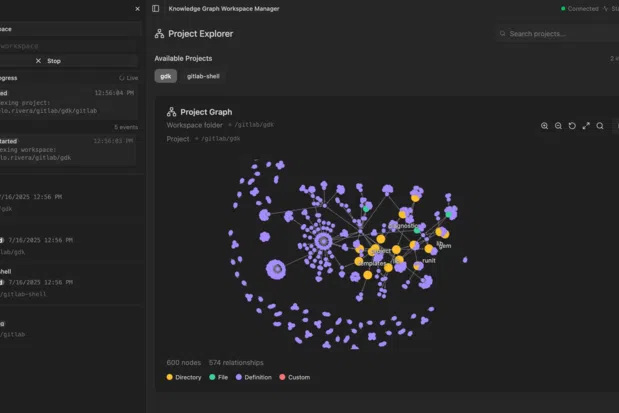How Singapore organisations can capture the S$6 billion AI opportunity
According to Sabrina Farmer, chief technology officer of GitLab, there are three major areas to take note of
ARTIFICIAL intelligence is already delivering measurable business value in Singapore, but many organisations struggle to scale its use. Recent research from GitLab, the most comprehensive AI-powered DevSecOps platform for software innovation, shows that AI-powered software innovation is generating annual savings of more than S$31,000 per developer. With about 200,000 developers in Singapore, that adds up to S$6.24 billion in potential value each year.

According to Sabrina Farmer, chief technology officer at GitLab, unlocking this opportunity requires a shift in mindset. Singapore executives are already on board, with 83 per cent saying they are prepared to allocate more than half of IT budgets to software innovation, and over 90 per cent of boards backing AI-driven transformation. The challenge now is execution.
“For many business leaders, being surrounded by AI solutions feels like being stranded on a desert island,” Farmer says. “There are natural resources everywhere, but without the right skills and infrastructure, you can’t harness them.”
Closing the human-AI partnership gap
Most executives in Singapore aim for a 50/50 partnership between human talent and AI in software development. But in reality, AI handles only about 25 per cent of the work, leaving potential untapped.
Executives would like to see AI handle a greater share of the work. Still, to operationalise it, leaders must connect development activities to business outcomes, focusing on problem-solving and direct business impact rather than just code volume.
Singapore organisations can bridge this gap by focusing on three strategic areas that address both immediate implementation challenges and long-term competitive advantage:
1. Choosing AI solutions that scale with your organisation
When the AI wave came, many organisations raced to adopt AI tools without a long-term plan. However, chasing immediate efficiency gains often results in fragmented adoption, where individuals accumulate their own point solutions.
“This creates silos,” Farmer says. “AI tools locked at the individual level only see part of the workflow, limiting their effectiveness.” She notes that fragmented AI adoption also introduces business risk, as intellectual property spreads across multiple systems without context.
Her advice is to shift to a platform-based approach that connects development activities to business outcomes and ask: “How do we solve this once for the entire organisation?” instead of “How do we solve this for our team?”
For example, GitLab has developed a Knowledge Graph that enables developers to navigate complex codebases better. Developers can understand and navigate their projects with greater context, making it easier to plan changes, perform impact analysis, and work with GitLab Duo agents to accelerate development tasks.

In many cases, understanding a company’s entire codebase would take most people several months to a few years, she says.
“You have to apply AI at a very high level.”
Farmer adds that teams also need guidance and training in AI-related skills, such as prompt engineering and data management. Approaching upskilling as a strategic investment ensures the human-AI partnership is fully leveraged.
2. Driving innovation with AI, not just efficiency
AI is not just about automating routine tasks. While it works well in that area, using it solely for that purpose means business leaders might miss out on real value creation. In particular, Farmer highlights that leaders who only view AI as a cost-cutting tool should think twice.
“If you adopt AI to replace engineers, you’re saying you’re fine with the status quo,” she says. “AI won’t take your company to the next level. Innovation comes from people.”
The chief technology officer adds that using AI in place of junior engineers also means that companies end up undermining their future workforce.
“You hire junior engineers not just for simple tasks – which you can use AI for – but as an investment,” she continues.

Companies should consider utilising AI tools for tasks that require some level of creativity or ingenuity, such as brainstorming solutions to operational problems or suggesting ideas for UI design. Humans will still be required to orchestrate those tasks fully, but they will be heavily assisted by AI tools, such as AI agents.
“I think AI agents are a game changer,” she says.
Additionally, while AI agents can be used to automate work, their true value lies in creating entire workflows, rather than executing individual tasks. Suppose a problem requires some level of knowledge and reasoning. In that case, an AI agent’s advantage is that it can analyse the issue, execute different combinations of steps depending on the problem, and pull data and knowledge across several teams to solve it immediately.
Effectively, it works like a high-level coordinator for the company, which can be triggered or left running to monitor its tech stack constantly.
“Some people think AI agents are just another team member, but I think it’s a problem if you only think of it that way,” Farmer says.
3. Adopting AI intentionally and securely
In the rush to keep pace, some companies select tools based on what is the most advanced or affordable in the short term. Farmer calls this the “AI leaderboard trap”.
“It creates a lot of churn,” she says. “The best tool today may not fit tomorrow’s needs.”
Instead, leaders must evaluate AI based on scalability, security, and alignment with business goals.
For sectors like finance, this is not just about efficiency but also compliance. A prototype built with an unsecured AI code editor could leave firms exposed to regulatory penalties.

“You have to think about the brand, how it might affect your reputation, and what the AI tool can ultimately do for your customers,” she says. “It’s not only about the bottom line.”
According to Farmer, the platform approach to adopting AI tools can help business leaders with this. GitLab offers an open ecosystem that emphasises seamless connectivity with external AI tools and systems while preserving key integration, oversight, and user experience benefits.
GitLab’s Model Context Protocol (MCP) server enables external AI systems to securely integrate with GitLab projects and development processes, eliminating the need for custom integration within GitLab environments.
Capturing Singapore’s AI opportunity
As AI continues to proliferate throughout the business world, Farmer sums up that the right mindset matters most. Organisations that capture AI’s value share three traits: strong technology leadership, platform-based approaches, and investment in human skills to work effectively with AI.
“It boils down to thinking about risk, your bottom line, but also the actual business value,” she says. “Get that balance right, and the S$6 billion opportunity becomes real.”
Learn more about GitLab and how it can help your organisation on its AI journey.

Share with us your feedback on BT's products and services
